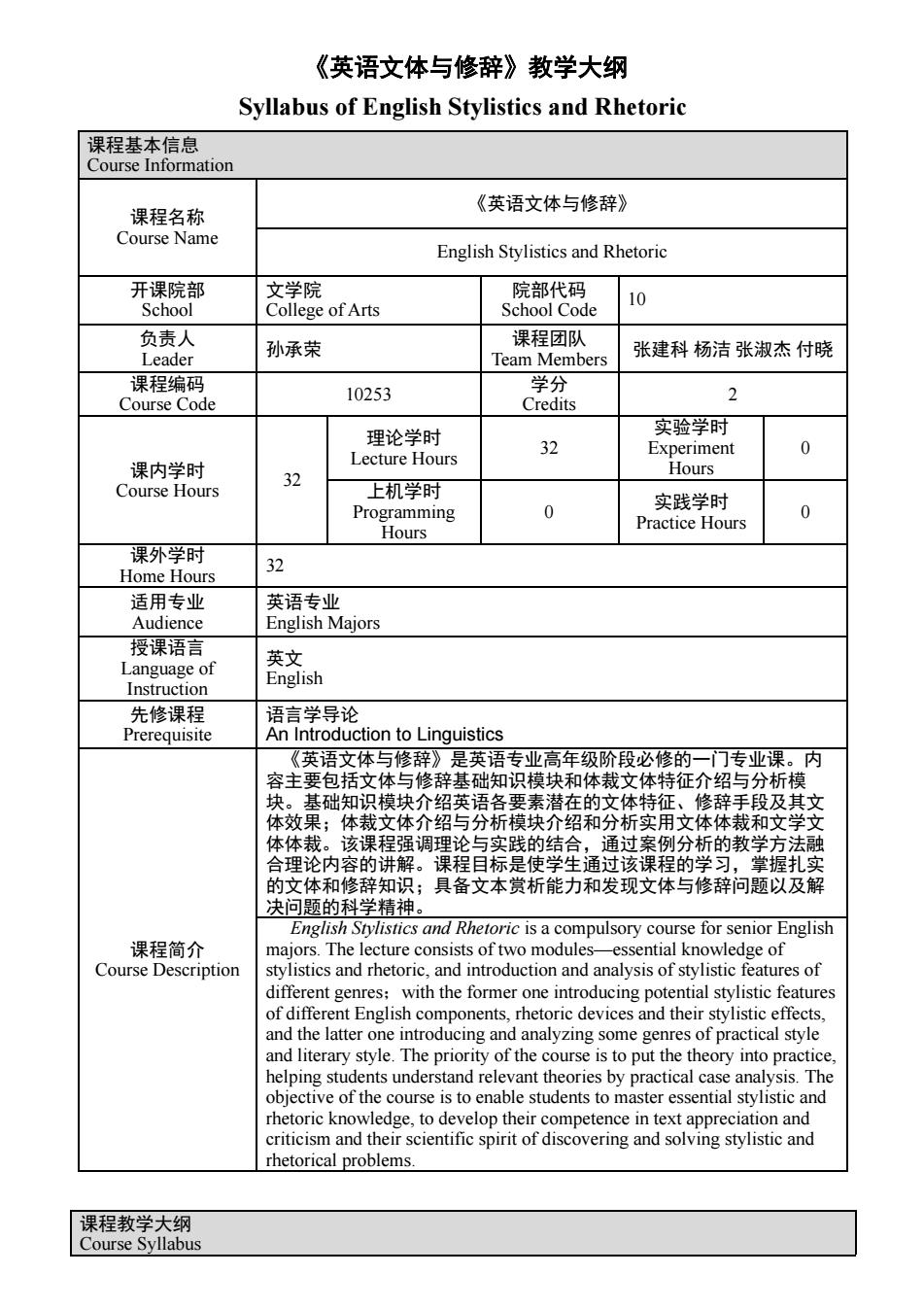
《英语文体与修辞》教学大纲 Syllabus of English Stylistics and Rhetoric 课程基本信息 Course Information 课程名称 《英语文体与修辞》 Course Nam English Stylistics and Rhetoric 开课院部 高ofAi 院部代码 School Code 10 School 负责人 Leader 孙承荣 课程团队 Team Men nbers 张建科杨洁张淑杰付晓 10253 卖验受时 论时 iment 0 课内学时 Course Hours 2 Hours 上机学时 Programming 实践学时 Practice Hours 0 Hours 课外学时 Home Hours 32 适用专业 英语专业 Audience English Majors 授课语言 Language of 济。 Instruction 先修课程 语言学导论 Prerequisite An Introduction to Linguistics 《英语文体与修辞》是英语专业高年级阶段必修的一门专业课。内 容主要包括文体与修辞基础知识模块和体裁文体特征介绍与分析模 ,基础知识模块介绍英语各要素潜在的文体特征、修辞手段及其文 体效果;体裁文体介绍与分析模块介绍和分析实用文体体裁和文学文 体体裁:该课程强调理珍实践的结全:通过例分析的教学方法融 理 容的讲解。 课程目 定1使 的与 决问题的 字猫神 Eng 课程简介 Course Description stvlistics and rhetoric.and introduction and analysis of stylistic features of different genres: with the former one introducing potential stylistic features of different English components.rhetoric devices and their stylistic effects and the latter one introducing and analyzing some genres of practical style and literary style.The priority of the course is to put the theory into practice helping stud objective of the course is to na oric knowie ge,to dev 课程教学大纲 Course Syllabus
《英语文体与修辞》教学大纲 Syllabus of English Stylistics and Rhetoric 课程基本信息 Course Information 课程名称 Course Name 《英语文体与修辞》 English Stylistics and Rhetoric 开课院部 School 文学院 College of Arts 院部代码 School Code 10 负责人 Leader 孙承荣 课程团队 Team Members 张建科 杨洁 张淑杰 付晓 课程编码 Course Code 10253 学分 Credits 2 课内学时 Course Hours 32 理论学时 Lecture Hours 32 实验学时 Experiment Hours 0 上机学时 Programming Hours 0 实践学时 Practice Hours 0 课外学时 Home Hours 32 适用专业 Audience 英语专业 English Majors 授课语言 Language of Instruction 英文 English 先修课程 Prerequisite 语言学导论 An Introduction to Linguistics 课程简介 Course Description 《英语文体与修辞》是英语专业高年级阶段必修的一门专业课。内 容主要包括文体与修辞基础知识模块和体裁文体特征介绍与分析模 块。基础知识模块介绍英语各要素潜在的文体特征、修辞手段及其文 体效果;体裁文体介绍与分析模块介绍和分析实用文体体裁和文学文 体体裁。该课程强调理论与实践的结合,通过案例分析的教学方法融 合理论内容的讲解。课程目标是使学生通过该课程的学习,掌握扎实 的文体和修辞知识;具备文本赏析能力和发现文体与修辞问题以及解 决问题的科学精神。 English Stylistics and Rhetoric is a compulsory course for senior English majors. The lecture consists of two modules—essential knowledge of stylistics and rhetoric, and introduction and analysis of stylistic features of different genres;with the former one introducing potential stylistic features of different English components, rhetoric devices and their stylistic effects, and the latter one introducing and analyzing some genres of practical style and literary style. The priority of the course is to put the theory into practice, helping students understand relevant theories by practical case analysis. The objective of the course is to enable students to master essential stylistic and rhetoric knowledge, to develop their competence in text appreciation and criticism and their scientific spirit of discovering and solving stylistic and rhetorical problems. 课程教学大纲 Course Syllabus
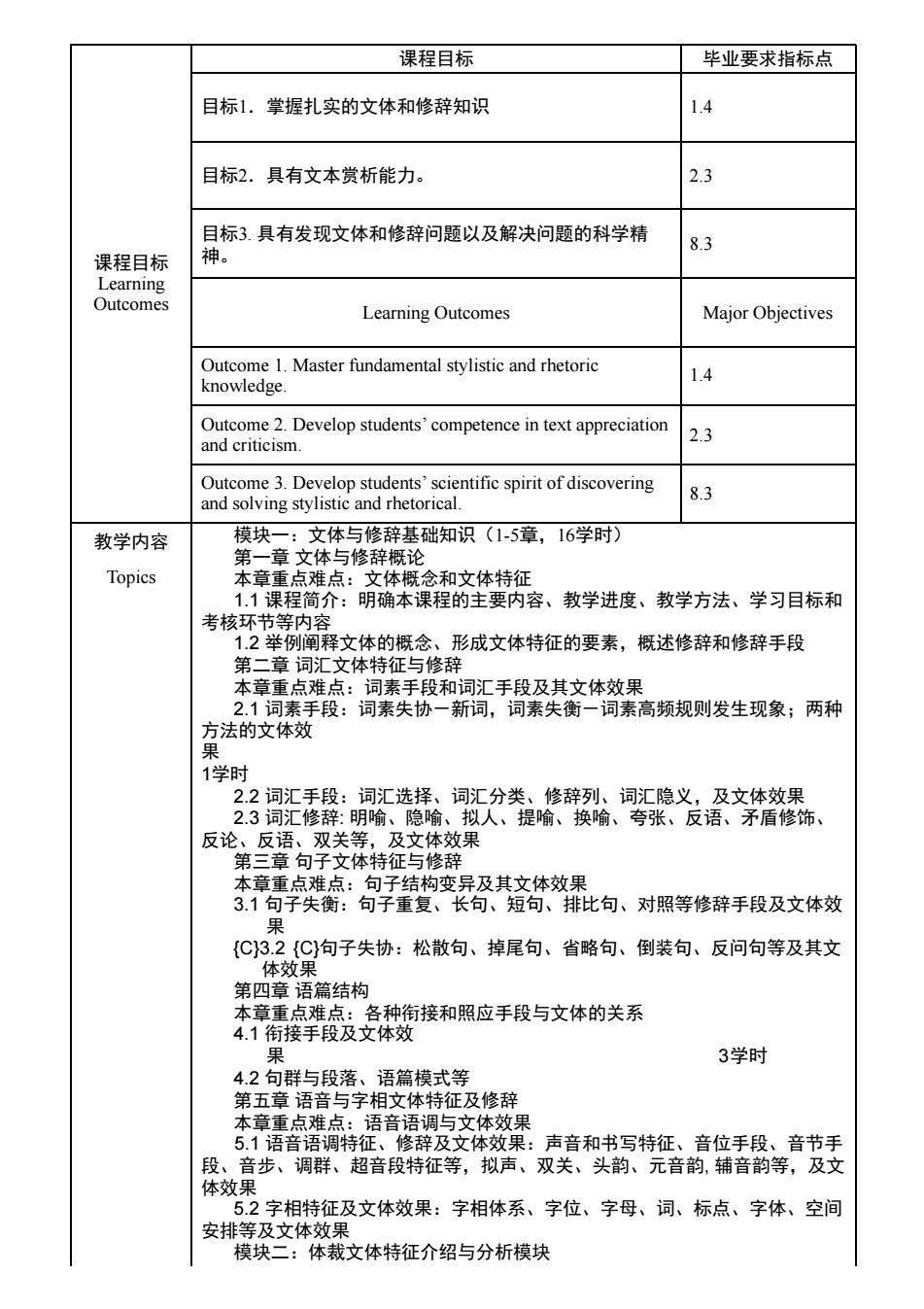
课程目标 毕业要求指标点 目标1.掌握扎实的文体和修辞知识 4 目标2.具有文本赏析能力。 2.3 目标3.具有发现文体和修辞问题以及解决问题的科学精 8.3 课程目标 神 Learning Outcomes Major Objectives Outcome 1.Master fundamental stylistic and rhetoric knowledge. 1.4 Outcome 2.Develop students'competence in text appreciation and criticism. cientific spirit of discovering 83 教学内容 模块一:文体与修辞基础知识(1-5章,16学时) 第一章文体与修辞概论 Topics 本章重点难点:文体概念和文体特征 1.1课程简介:明确本课程的主要内容、教学进度、教学方法、学习目标和 考核环节等内容 12举例阐释文体的概念、形成文体特征的要素,概述修辞和修辞手段 第二章词汇文体特征与修辞 本章重点难点:词素手段和词汇手段及其文体效果 菊法的文保费 21词素手段:词素失协一新词,词素失衡一词素高频规则发生现象;两种 1学时 词汇选择 明喻、隐 茶餐句、对等特手发及文体效 C32C句子失协:松散句、掉尾句、省略句、倒装句、反问句等及其文 体效果 第四章语篇结构 本章重点难点:各种衔接和照应手段与文体的关系 4.1衔接手段及文体效 果 3学时 4.2句群与段落、语篇模式等 第五章语音与字相文体特征及修辞 本章重点难点:语音语调与文体效果 5.1语音语调特征、修辞及文体效果:声音和书写特征、音位手段、音节手 段、音步、调群、超音段特征等,拟声、双关、头韵、元音韵,辅音韵等,及文 体效果 2字相特征及文体效果:字相体系、字位、字母、词、标点、字体、空间 安排等及文体效果 模块二:体裁文体特征介绍与分析模块
课程目标 Learning Outcomes 课程目标 毕业要求指标点 目标1.掌握扎实的文体和修辞知识 1.4 目标2.具有文本赏析能力。 2.3 目标3. 具有发现文体和修辞问题以及解决问题的科学精 神。 8.3 Learning Outcomes Major Objectives Outcome 1. Master fundamental stylistic and rhetoric knowledge. 1.4 Outcome 2. Develop students’ competence in text appreciation and criticism. 2.3 Outcome 3. Develop students’ scientific spirit of discovering and solving stylistic and rhetorical. 8.3 教学内容 Topics 模块一:文体与修辞基础知识(1-5章,16学时) 第一章 文体与修辞概论 本章重点难点:文体概念和文体特征 1.1 课程简介:明确本课程的主要内容、教学进度、教学方法、学习目标和 考核环节等内容 1.2 举例阐释文体的概念、形成文体特征的要素,概述修辞和修辞手段 第二章 词汇文体特征与修辞 本章重点难点:词素手段和词汇手段及其文体效果 2.1 词素手段:词素失协-新词,词素失衡-词素高频规则发生现象;两种 方法的文体效 果 1学时 2.2 词汇手段:词汇选择、词汇分类、修辞列、词汇隐义,及文体效果 2.3 词汇修辞: 明喻、隐喻、拟人、提喻、换喻、夸张、反语、矛盾修饰、 反论、反语、双关等,及文体效果 第三章 句子文体特征与修辞 本章重点难点:句子结构变异及其文体效果 3.1 句子失衡:句子重复、长句、短句、排比句、对照等修辞手段及文体效 果 {C}3.2 {C}句子失协:松散句、掉尾句、省略句、倒装句、反问句等及其文 体效果 第四章 语篇结构 本章重点难点:各种衔接和照应手段与文体的关系 4.1 衔接手段及文体效 果 3学时 4.2 句群与段落、语篇模式等 第五章 语音与字相文体特征及修辞 本章重点难点:语音语调与文体效果 5.1 语音语调特征、修辞及文体效果:声音和书写特征、音位手段、音节手 段、音步、调群、超音段特征等,拟声、双关、头韵、元音韵, 辅音韵等,及文 体效果 5.2 字相特征及文体效果:字相体系、字位、字母、词、标点、字体、空间 安排等及文体效果 模块二:体裁文体特征介绍与分析模块
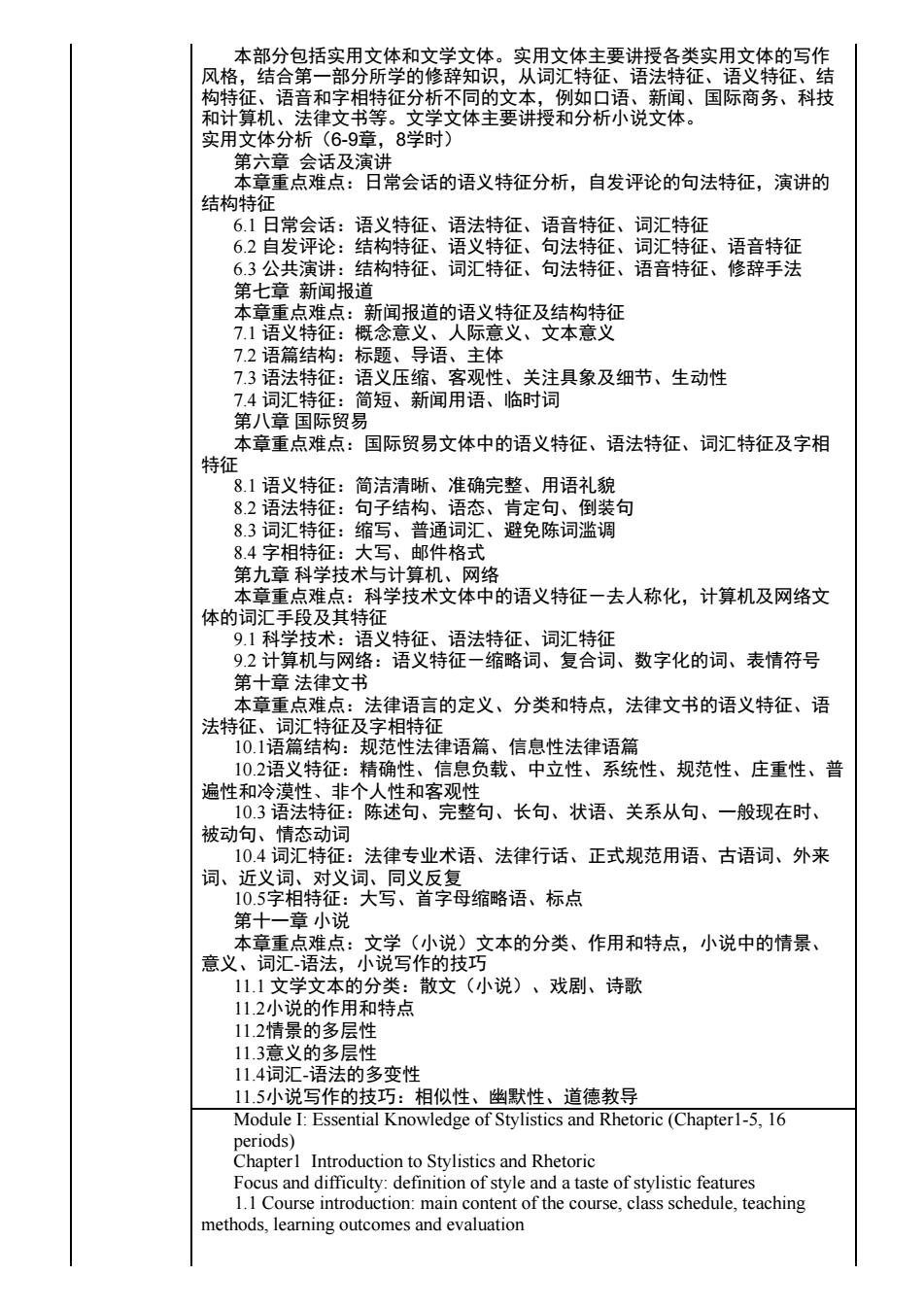
本部分包括实用文体和文学文体。实用文体主要讲授各类实用文体的写作 风格结合笔和分所学的修辞相: 特征 主讲授和分 、国际商务、科技 实用文体分析 (6.9音 8学时) 通 第六章会话及计 本章重点难点:日常会话的语义特征分析,自发评论的句法特征,演讲的 结构特征 6.1日常会话:语义特征、语法特征、语音特征、词汇特征 62自发评论:结构特征、语义特征、句法特征、词汇特征、语音特征 63公共演讲:结构特征、词汇特征、句法特征、语音特征、修辞手法 第七章新闻报道 本章重点难点:新闻报道的语义特征及结构特征 71语义特征:概念意义、人际意义、文本意义 72语篇结构:标题、导语、主体 73语法特征:语义压缩、客观性、关注具象及细节、生动性 7.4词汇特征:简短、新闻用语、临时词 第八章国际贸易 本章重点难点:国际贸易文体中的语义特征、语法特征、词汇特征及字相 特征 简洁清晰、准确完整、用语礼貌 缩写、 ,避免陈词滥调 84字相 与、 体的杰章重 科学技术文体中的语义特征一去人称化,计算机及网络文 n甘 91科学技术语义特征、语法特征、词汇特征 92计算机与网络:语义特征二缩略词、复合词、数字化的词、表情符号 第十章法律文书 本章重点难点:法律语言的定义、分类和特点,法律文书的语义特征、语 法特征、词汇特征及字相特征 10.1语篇结构:规范性法律语篇、信息性法律语篇 10.2语义特征:精确性、信息负载、中立性、系统性、规范性、庄重性、普 遍性和冷漠性、非个人性和客观性 10.3语法特征:陈述句、完整句、长句、状语、关系从句、一般现在时、 被动句、情态动词 10.4词汇特征:法律专业术语、法律行话、正式规范用语、古语词、外来 词、近义词、对义词、同义反复 10,5字相特征:大写、首字母缩略语、标点 第 章小说 本重点 文学(小说)文本的分类、作用和特点,小说中的情景、 意义、词 与F的 文本 的分类:散文(小说)、戏剧、诗歌 的作 和特点 11.2情景的多 八铜说写作的技巧:相似性幽默性,道德教导 多变性 Module I:Essential Knowledge of Stylistics and Rhetoric(Chapter1-5,16 periods) apter Introduction to Stylistics and Rheto Cou e of rse introduetion:main content of the course. methods.learning outcomes and evaluation
本部分包括实用文体和文学文体。实用文体主要讲授各类实用文体的写作 风格,结合第一部分所学的修辞知识,从词汇特征、语法特征、语义特征、结 构特征、语音和字相特征分析不同的文本,例如口语、新闻、国际商务、科技 和计算机、法律文书等。文学文体主要讲授和分析小说文体。 实用文体分析(6-9章,8学时) 第六章 会话及演讲 本章重点难点:日常会话的语义特征分析,自发评论的句法特征,演讲的 结构特征 6.1 日常会话:语义特征、语法特征、语音特征、词汇特征 6.2 自发评论:结构特征、语义特征、句法特征、词汇特征、语音特征 6.3 公共演讲:结构特征、词汇特征、句法特征、语音特征、修辞手法 第七章 新闻报道 本章重点难点:新闻报道的语义特征及结构特征 7.1 语义特征:概念意义、人际意义、文本意义 7.2 语篇结构:标题、导语、主体 7.3 语法特征:语义压缩、客观性、关注具象及细节、生动性 7.4 词汇特征:简短、新闻用语、临时词 第八章 国际贸易 本章重点难点:国际贸易文体中的语义特征、语法特征、词汇特征及字相 特征 8.1 语义特征:简洁清晰、准确完整、用语礼貌 8.2 语法特征:句子结构、语态、肯定句、倒装句 8.3 词汇特征:缩写、普通词汇、避免陈词滥调 8.4 字相特征:大写、邮件格式 第九章 科学技术与计算机、网络 本章重点难点:科学技术文体中的语义特征-去人称化,计算机及网络文 体的词汇手段及其特征 9.1 科学技术:语义特征、语法特征、词汇特征 9.2 计算机与网络:语义特征-缩略词、复合词、数字化的词、表情符号 第十章 法律文书 本章重点难点:法律语言的定义、分类和特点,法律文书的语义特征、语 法特征、词汇特征及字相特征 10.1语篇结构:规范性法律语篇、信息性法律语篇 10.2语义特征:精确性、信息负载、中立性、系统性、规范性、庄重性、普 遍性和冷漠性、非个人性和客观性 10.3 语法特征:陈述句、完整句、长句、状语、关系从句、一般现在时、 被动句、情态动词 10.4 词汇特征:法律专业术语、法律行话、正式规范用语、古语词、外来 词、近义词、对义词、同义反复 10.5字相特征:大写、首字母缩略语、标点 第十一章 小说 本章重点难点:文学(小说)文本的分类、作用和特点,小说中的情景、 意义、词汇-语法,小说写作的技巧 11.1 文学文本的分类:散文(小说)、戏剧、诗歌 11.2小说的作用和特点 11.2情景的多层性 11.3意义的多层性 11.4词汇-语法的多变性 11.5小说写作的技巧:相似性、幽默性、道德教导 Module I: Essential Knowledge of Stylistics and Rhetoric (Chapter1-5, 16 periods) Chapter1 Introduction to Stylistics and Rhetoric Focus and difficulty: definition of style and a taste of stylistic features 1.1 Course introduction: main content of the course, class schedule, teaching methods, learning outcomes and evaluation

1.2 General introduction of style by illustration,components of stylistic features, rhetoric and rhetoric devices Chapter Stylistic Features and Rhetorical Devices culty:morph their stylistic effect devices phemic qual r deflectio and high nce effects achieved by the ty 2.2 Lexical Devices:selection of words,classification of words,rhetorical series word implications;and their stylistic effects Rhetorical devices:simile,metaphor,personification,synecdoche,metonymy hyperbole,litotes/meiosis,oxymoron,paradox,irony,pun etc.;and their stylistic actic Stylistic Features anc and . and their stylistic efect short se antithesi and their sylistic e 3.2 Syntactic Incongruity/Qualitative Deviation:loose sentence.pe sentence,elliptical sentence,inverted sentence,rhetorical question etc;and their stylistic effects Chapter 4 Text Structure(Semantics) culty:coh on and style. 4.2 o esive de d the tic effects gro passa erns of te ext str ap ures anc nd t 5I Phonological features rhetorical devices and their stvlistic effects characteristics of sound and writing,phonemic devices,syllabic devices,foot,tone group,suprasegmental features etc. onomatopoela,pun,alliteration,assonance, consonance etc;and their stylistic effects 5.2 Phonological features and heir stylistic ffects:graphological System ters,words,punctuation marks,types,spati arrangement etc;and their Module Introduction and Analysis of Stylistic Fea s of Diffe nt Ge This section style.In the nart of the p tical style analysis.knowlede learned in the first module is applied to an ractical styles.such as conversations and speeches,news report,international business, science and technology,computer and internet.Style features from the aspects of wording,grammar,semantics,text phonology and graphology are also covered. Practical Style(Chapter 6-9,8 periods) ulty of daily conversation,syntactic features of pon 6 I Daily cor mmatical features.phonological features.lexical features 6.2 Spontaneous commentary:text structures,semantic features,syntactic features,lexical features,phonological features 6.3 Public speech:text structures,lexical features,syntactic features. phonological fea tures rhetorical devices Chapter eport and d aning,interpers( 7.3 Grammatical features:meaning contraction,objectivity,concreteness and detailedness,vividness 7.4 Lexical features:short,journalese phrase,nonce words Chapter International Business
1.2 General introduction of style by illustration, components of stylistic features, rhetoric and rhetoric devices Chapter 2 Lexical Stylistic Features and Rhetorical Devices Focus and difficulty: morphemic devices, lexical devices and their stylistic effects 2.1 Morphemic devices: morphemic qualitative deviation or incongruity — neologisms, morphemic quantitative deviation or deflection — overregularity and high frequency of occurrence;stylistic effects achieved by the two methods 2.2 Lexical Devices: selection of words, classification of words, rhetorical series, word implications; and their stylistic effects Rhetorical devices: simile, metaphor, personification, synecdoche, metonymy, hyperbole, litotes/meiosis, oxymoron, paradox, irony, pun etc.; and their stylistic effects Chapter 3 Syntactic Stylistic Features and Rhetoric Focus and difficulty: varieties of sentence structure and their stylistic effect 3.1 Syntactic deflection/ quantitative deviation: sentence repetition, long sentences, short sentences, parallelism, antithesis etc; and their stylistic effects 3.2 Syntactic Incongruity/Qualitative Deviation: loose sentence, periodic sentence, elliptical sentence, inverted sentence, rhetorical question etc; and their stylistic effects Chapter 4 Text Structure (Semantics) Focus and difficulty: cohesion and style. 4.1 Cohesive devices and their stylistic effects. 4.2 Sentence groups, paragraphs and passages, patterns of text structure. Chapter 5 Phonological and Graphological Stylistic Features and Rhetoric Focus and difficulty: phonology and their stylistic effects 5.1 Phonological features, rhetorical devices and their stylistic effects: characteristics of sound and writing, phonemic devices, syllabic devices, foot, tone group, suprasegmental features etc., onomatopoeia, pun, alliteration, assonance, consonance etc; and their stylistic effects 5.2 Phonological features and their stylistic effects: graphological System — grapheme, letters, words, punctuation marks, types, spatial arrangement etc; and their stylistic effects. Module II: Introduction and Analysis of Stylistic Features of Different Genres This section includes practical style and literary style. In the part of the practical style analysis, knowledge learned in the first module is applied to analyze practical styles, such as conversations and speeches, news report, international business, science and technology, computer and internet. Style features from the aspects of wording, grammar, semantics, text phonology and graphology are also covered. Practical Style (Chapter 6-9, 8 periods) Chapter 6 Conversations and Speeches Focus and difficulty: semantic features of daily conversation, syntactic features of spontaneous commentary, public speech’s text structures 6.1 Daily conversation: semantic features, grammatical features, phonological features, lexical features 6.2 Spontaneous commentary: text structures, semantic features, syntactic features, lexical features, phonological features 6.3 Public speech: text structures, lexical features, syntactic features, phonological features, rhetorical devices Chapter 7 News Report Focus and difficulty: semantic features and text structures in news report 7.1 Semantic features: ideational meaning, interpersonal meaning, textual meaning 7.2 Text structures: headline, guide, body 7.3 Grammatical features: meaning contraction, objectivity, concreteness and detailedness, vividness 7.4 Lexical features: short, journalese phrase, nonce words Chapter 8 International Business

Focusiffcuymnic features,grammatical features,exical features, features:clearness and conciseness,correctness and completeness inverted sentences 8.3 Lexical features:abbreviation,common words,avoid cliches .4 Graphological features:capitalization,arrangement of typesetting Chapter 9 Science and Technology,Computer and Internet Focus and difficulty:semantic features in science and technology- depersonification,lexical features in computer and internet 9.1 Science and technology:semantic features.grammatical features,lexical omrintemet smantie features abrevition blendingmred word Focus and difficulty:definition,classification and characteristics of legal language,textual structure,semantic features,grammatical features,lexical features. graphological features in legal documents 10.1 Textual structure:regulatory text,informative text character, matical features:declarative sentence,complete sent clause sim nle 10.4 Lexical features:legal terms of art,legalese (legal jarg n).formal and formative word,archaic word,load word,synonym(doublet,triplet),antonym, ppolocapunctio Chapter 11 Fictior ataiecaeaiaom.iacionandchaatoritcsoftea 11.1 Categorization of literary texts:prose(fiction),drama,poetry 11.2 Functions and characteristics of fiction 11.3 The multi-level situations co-grammar The basic techniques of fictional writing:iconicity,humorousness,moral 内容 翻 教学方式 课外 学 课外环节 课程目标 1.1 0.5 教学进度及 讲授 目标1,2,3 要求 1.2 1.5 讲授、讨论 作业 目标1,2 Class 2.1 1 讲授、讨论 1 作业 目标1,2 Schedule& Requirements 2.2 讲授、讨论 作业 目标1,2 2.3 1 讲授、讨论 1 作业 目标1,2 3.1 2 讲授、讨论 作业 目标1,2
Focus and difficulty: semantic features, grammatical features, lexical features, graphological features in international business 8.1Semantic features: clearness and conciseness, correctness and completeness, consideration and courtesy 8.2Grammatical features: sentence structure, voice, affirmative sentences, inverted sentences 8.3 Lexical features: abbreviation, common words, avoid clichés 8.4 Graphological features: capitalization, arrangement of typesetting Chapter 9 Science and Technology, Computer and Internet Focus and difficulty: semantic features in science and technology— depersonification, lexical features in computer and internet 9.1 Science and technology: semantic features, grammatical features, lexical features 9.2 Computer and internet: semantic features—abbreviation, blending, numbered words, emoticons Chapter 10 Legal Documents Focus and difficulty: definition, classification and characteristics of legal language, textual structure, semantic features, grammatical features, lexical features, graphological features in legal documents 10.1 Textual structure: regulatory text, informative text 10.2 Semantic features: preciseness, information (over)load, neutrality, systemic character, formalism, solemnity, universality and aloofness, impersonality and objectivization 10.3 Grammatical features: declarative sentence, complete sentence, long sentence, adverbial, relative clause, simple present tense, passive voice, modality 10.4 Lexical features: legal terms of art, legalese (legal jargon), formal and formative word, archaic word, load word, synonym (doublet, triplet), antonym, tautology 10.5 Graphological features: capitalization, acronym, punctuation Chapter 11 Fiction Focus and difficulty: categorization, function and characteristics of literary (fictional) texts, situations, meanings, lexico-grammar in fiction, the basic techniques of fictional writing 11.1 Categorization of literary texts: prose (fiction), drama, poetry 11.2 Functions and characteristics of fiction 11.3 The multi-level situations 11.4 The multi-level meanings 11.5 The multi-variance of lexico-grammar 11.6 The basic techniques of fictional writing: iconicity, humorousness, moral teaching 教学进度及 要求 Class Schedule & Requirements 内容 课内 学时 教学方式 课外 学时 课外环节 课程目标 1.1 0.5 讲授 目标1,2,3 1.2 1.5 讲授、讨论 2 作业 目标1,2 2.1 1 讲授、讨论 1 作业 目标1,2 2.2 2 讲授、讨论 2 作业 目标1,2 2.3 1 讲授、讨论 1 作业 目标1,2 3.1 2 讲授、讨论 2 作业 目标1,2
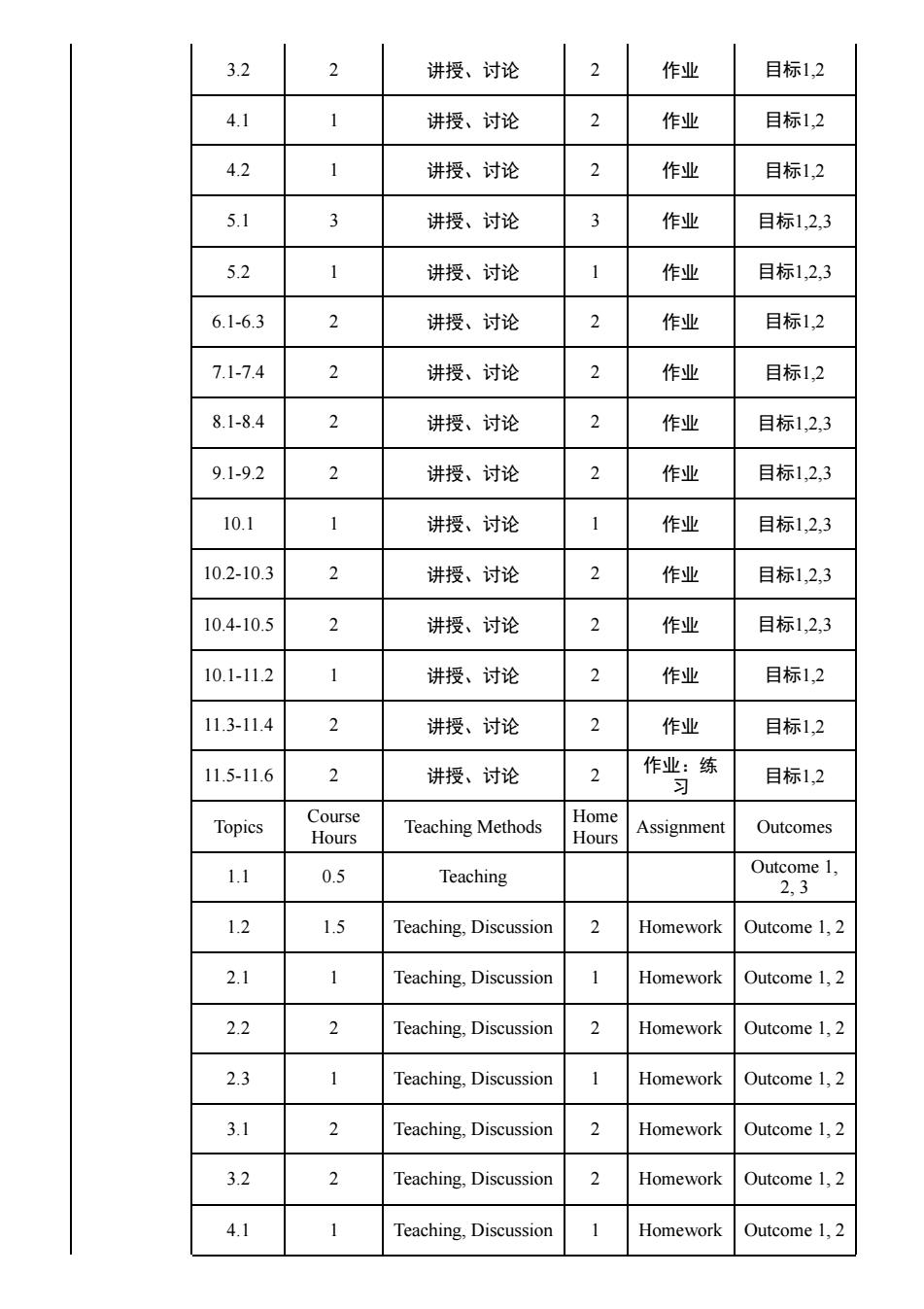
32 2 讲授、讨论 2 作业 目标1,2 4.1 讲授、讨论 作业 目标1,2 讲授、讨论 2 作业 目标1,2 5.1 讲授、讨论 3 作业 目标12,3 5.2 1 讲授、讨论 作业 目标1,2,3 6.1-6.3 讲授、讨论 作业 目标1,2 7.1-7.4 2 讲授、讨论 2 作业 目标1,2 8.1-84 讲授、讨论 作业 目标12,3 9.1-9.2 2 讲授、讨论 2 作业 目标12,3 10.1 讲授、讨论 作业 目标12,3 10.2-10.3 2 讲授、讨论 2 作业 目标1,2,3 10.410.5 讲授、讨论 作业 目标1,2,3 10.1-112 讲授、讨论 2 作业 目标1,2 11.3-11.4 讲授、讨论 2 作业 目标1,2 11.5-11.6 2 讲授、讨论 作业:练 目标12 习 Topics Teaching Methods Assignment Outcomes 1.1 0.5 Teaching Outcome 1, 2.3 1.2 1.5 Teaching,Discussion 2 Homework Outcome 1,2 2.1 Teaching,Discussion Homework Outcome 1,2 2.2 2 Teaching,Discussion 2 Homework Outcome1,2 2.3 Teaching.Discussion Homework Outcome 1,2 3.1 2 Teaching.Discussion 2 Homework Outcome 1,2 Teaching,Discussion Homework Outcome 1.2 41 Teaching.Discussion Homework Outcome1.2
3.2 2 讲授、讨论 2 作业 目标1,2 4.1 1 讲授、讨论 2 作业 目标1,2 4.2 1 讲授、讨论 2 作业 目标1,2 5.1 3 讲授、讨论 3 作业 目标1,2,3 5.2 1 讲授、讨论 1 作业 目标1,2,3 6.1-6.3 2 讲授、讨论 2 作业 目标1,2 7.1-7.4 2 讲授、讨论 2 作业 目标1,2 8.1-8.4 2 讲授、讨论 2 作业 目标1,2,3 9.1-9.2 2 讲授、讨论 2 作业 目标1,2,3 10.1 1 讲授、讨论 1 作业 目标1,2,3 10.2-10.3 2 讲授、讨论 2 作业 目标1,2,3 10.4-10.5 2 讲授、讨论 2 作业 目标1,2,3 10.1-11.2 1 讲授、讨论 2 作业 目标1,2 11.3-11.4 2 讲授、讨论 2 作业 目标1,2 11.5-11.6 2 讲授、讨论 2 作业:练 习 目标1,2 Topics Course Hours Teaching Methods Home Hours Assignment Outcomes 1.1 0.5 Teaching Outcome 1, 2, 3 1.2 1.5 Teaching, Discussion 2 Homework Outcome 1, 2 2.1 1 Teaching, Discussion 1 Homework Outcome 1, 2 2.2 2 Teaching, Discussion 2 Homework Outcome 1, 2 2.3 1 Teaching, Discussion 1 Homework Outcome 1, 2 3.1 2 Teaching, Discussion 2 Homework Outcome 1, 2 3.2 2 Teaching, Discussion 2 Homework Outcome 1, 2 4.1 1 Teaching, Discussion 1 Homework Outcome 1, 2
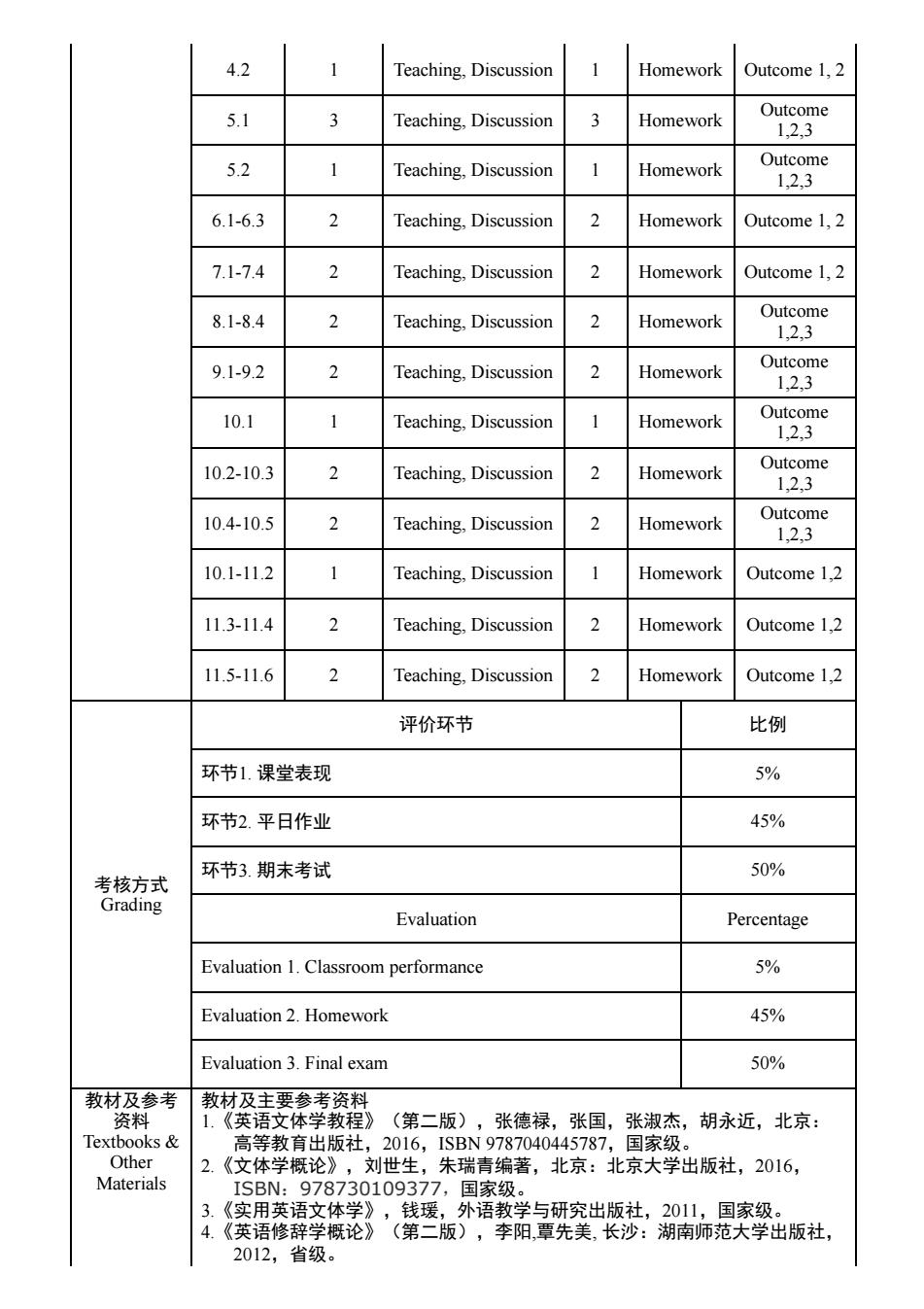
4.2 1 Teaching,Discussion Homework Outcome 1,2 5.1 Teaching,Discussion 3 Homework 01 5.2 Teaching,Discussion Homework Outcome 1.2.3 6.1-6.3 Teaching,Discussion 2 Homework Outcome1,2 7.1-7.4 2 Teaching,Discussion Homework 8.1-8.4 2 Teaching.Discussion Homework 9.1-92 2 Teaching,Discussion 3 Homework 10.1 Teaching,Discussion Homework Ouome 10.2-10.3 2 Teaching,Discussion 2 Homework 10.4-10.5 Teaching,Discussion Homework Outcome 12.3 10.1-11.2 1 Teaching,Discussion 1 Homework Outcome 1,2 11.3-11.4 Teaching.Discussion Homework Outcome 1.2 11.5-11.6 2 Teaching,Discussion Homework 评价环节 比例 环节1.课堂表现 5% 环节2.平日作业 45% 环节3.期末考试 50% Evaluation Percentage Evaluation 1.Classroom performance 5% Evaluation 2.Homework 45% Evaluation 3.Final exam 50% 教材及参考 教材及主要参考资料 资料 1.《英语文体学教程》(第二版),张德禄,张国,张淑杰,胡永近,北京: s& 高等教育出版社,2016,ISBN9787040445787,国家级。 Materials 2. 《文体学概论》,刘世生,朱瑞青编著,北京:北京大学出版社,2016, ISBN:978730109377,国家级。 《实用英语文体学》,钱瑗,外语教学与研究出版社,2011,国家级。 4. 《英语修辞学概论》(第二版),李阳,覃先美,长沙:湖南师范大学出版社, 2012,省级
4.2 1 Teaching, Discussion 1 Homework Outcome 1, 2 5.1 3 Teaching, Discussion 3 Homework Outcome 1,2,3 5.2 1 Teaching, Discussion 1 Homework Outcome 1,2,3 6.1-6.3 2 Teaching, Discussion 2 Homework Outcome 1, 2 7.1-7.4 2 Teaching, Discussion 2 Homework Outcome 1, 2 8.1-8.4 2 Teaching, Discussion 2 Homework Outcome 1,2,3 9.1-9.2 2 Teaching, Discussion 2 Homework Outcome 1,2,3 10.1 1 Teaching, Discussion 1 Homework Outcome 1,2,3 10.2-10.3 2 Teaching, Discussion 2 Homework Outcome 1,2,3 10.4-10.5 2 Teaching, Discussion 2 Homework Outcome 1,2,3 10.1-11.2 1 Teaching, Discussion 1 Homework Outcome 1,2 11.3-11.4 2 Teaching, Discussion 2 Homework Outcome 1,2 11.5-11.6 2 Teaching, Discussion 2 Homework Outcome 1,2 考核方式 Grading 评价环节 比例 环节1. 课堂表现 5% 环节2. 平日作业 45% 环节3. 期末考试 50% Evaluation Percentage Evaluation 1. Classroom performance 5% Evaluation 2. Homework 45% Evaluation 3. Final exam 50% 教材及参考 资料 Textbooks & Other Materials 教材及主要参考资料 1.《英语文体学教程》(第二版),张德禄,张国,张淑杰,胡永近,北京: 高等教育出版社,2016,ISBN 9787040445787,国家级。 2.《文体学概论》,刘世生,朱瑞青编著,北京:北京大学出版社,2016, ISBN:978730109377,国家级。 3.《实用英语文体学》,钱瑗,外语教学与研究出版社,2011,国家级。 4.《英语修辞学概论》(第二版),李阳,覃先美, 长沙:湖南师范大学出版社, 2012,省级
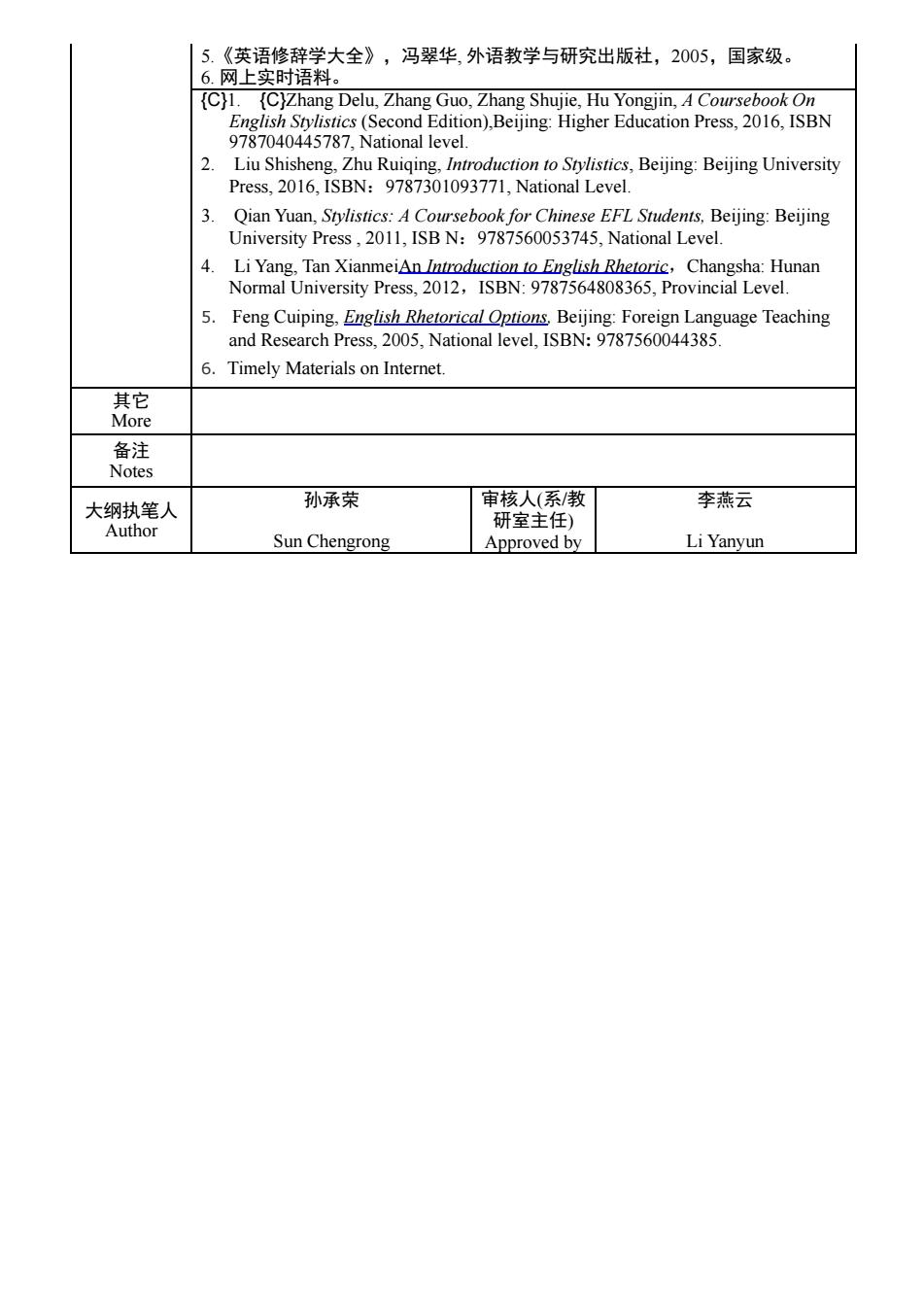
5.《英语修辞学大全》,冯翠华,外语教学与研究出版社,2005,国家级。 6.网上实时语料。 {C)1.(C)Zhang Delu,Zhang Guo,Zhang Shujie,Hu Yongjin,A Coursebook On enghe c6.1s Liu Shisheng.Zhu Ruiqing.Introduction to Srylistics,Beijing:Beijing University Press,2016,ISBN:9787301093771,National Level. 3. Qian Yuan,Srvlistics:A Coursebook for Chinese EFL Students,Beijing:Beijing University Press,2011,ISB N:9787560053745,National Level 4. Li Yang.Tan XianmeiAn Introduction to Euglish Rhetoric,Changsha:Hunan Normal University Press.2012,ISBN:9787564808365.Provincial Level. 5. 6.Timely Materials on Internet. 魅 大纲执笔人 孙承荣 审核人(系/教 李燕云 Author 研室主任) Sun Chengrong Approved by Li Yanyun
5.《英语修辞学大全》,冯翠华, 外语教学与研究出版社,2005,国家级。 6. 网上实时语料。 {C}1. {C}Zhang Delu, Zhang Guo, Zhang Shujie, Hu Yongjin, A Coursebook On English Stylistics (Second Edition),Beijing: Higher Education Press, 2016, ISBN 9787040445787, National level. 2. Liu Shisheng, Zhu Ruiqing, Introduction to Stylistics, Beijing: Beijing University Press, 2016, ISBN:9787301093771, National Level. 3. Qian Yuan, Stylistics: A Coursebook for Chinese EFL Students, Beijing: Beijing University Press , 2011, ISB N:9787560053745, National Level. 4. Li Yang, Tan XianmeiAn Introduction to English Rhetoric,Changsha: Hunan Normal University Press, 2012,ISBN: 9787564808365, Provincial Level. 5. Feng Cuiping, English Rhetorical Options, Beijing: Foreign Language Teaching and Research Press, 2005, National level, ISBN: 9787560044385. 6. Timely Materials on Internet. 其它 More 备注 Notes 大纲执笔人 Author 孙承荣 Sun Chengrong 审核人(系/教 研室主任) Approved by 李燕云 Li Yanyun